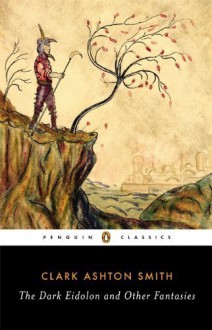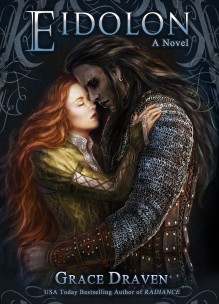
Clark Ashton Smith is a name that exists at the periphery of science fiction and fantasy lore, a name often evoked but rarely read. He is sometimes dismissed as an imitator of Lovecraft; at other times, as a writer whose exotic, hot-house prose often carried him away from his subjects. Yet the titles of his numerous short stories are too tempting to leave to second-hand wisdom: works like “The City of the Singing Flame,” “The Dark Eidolon,” and “Ubbo-Sathla” remind me of long-lost AD&D campaigns and hidden, forgotten evils buried in the appendix of the Fiend Folio. There’s some truth to this, as without Clark’s stories, so much of the modern fantasy mythos would cease to exist. Along with Lovecraft and Tolkein, Smith’s stories were mined for their outlandish visions of Atlantean worlds and unspeakable terrors. What others left behind was Smith’s unique language—he is unparalleled as a crafter of prose in fantasy writing—and his ability to create tension and twist endings. Smith excelled at the short story, and a 10-page tale from Smith often contains more beauty, wonder, and mystery than many a thousand-page tome making lavish promises on its book jacket.
Smith emerged in the golden age of fantasy writing in America, at the same time as Lovecraft and many of the long-forgotten magazines devoted to weird and strange tales. However, he worked largely in isolation in California, ignored by the literary establishment and often rejected from the very magazines he read for inspiration and fellowship. Lovecraft, among others, recognized his talent and did whatever he could to promote his works (it helped that Smith often wrote stories in the Cthulu mythos—an early example of fan fiction). Yet Smith’s weakness (or strength, depending on your inclination) was his similarity to his closest literary precursor: Edgar Allen Poe. Like Poe, Smith thought himself primarily a poet, and his prose is often drenched in fantastic imagery and arcane—yet sensuously beautiful—wording. A typical example from his Gothic fantasy story, “The Dark Eidolon” illustrates Smith’s trademark prose:
In the wide intervals between the tables, the familiars of Namirrha and his other servants went to and fro incessantly, as if a phantasmagoria of ill dreams were embodied before the emperor. Kingly cadavers in robes of time-rotten brocade, with worms seething in their eye-pits, poured a blood-like wine into cups of the opalescent horn of unicorns. Lamias, trident-tailed, and four-breasted chimeras, came in with fuming platters lifted high by their brazen claws. Dog-headed devils, tongued with lolling flames, ran forward to offer themselves as ushers for the company...
To be fair, this is Smith in his headiest, hell-for-leather mode, which he employed in his most exotic tales of fantasy. It frankly put some editors off, and his stories were often rejected for being too slow and not having the right “punch” for their semi-literate audience. Like many fantasy writers today, Smith ended up self-publishing some of his stories, as he was only willing to compromise so much (though he did trim and re-write many of his tales, with the intention of restoring the originals in due time). Yet even in his most rhapsodic writing, his ability to play with the sounds of English and twist them into pure sound is astonishing. Like the Middle English of the Pearl poet or even Chaucer himself, Smith loves the fragrance of words and the pungent play of alliteration and assonance. Look, for example, at this dazzling sentence “Kingly cadavers in robes of time-rotten brocade, with worms seething in their eye-pits, poured a blood-like wine into cups of the opalescent horn of unicorns.” While it paints a wonderful (gruesome) picture, it is less about sense than sound, with the “k” sound of “kingly cadavers...brocade,” melting into the more soothing “s” sound of “opalescent...unicorns” It’s a painting in prose, resembling the shimmering medieval coloring of the Pre-Raphaelite painters, or the decadent orchestration of Scriabin’s Poem of Ecstasy (1908).
However, Smith was more than colorful writing and arcane turns of phrase; his storytelling ability is unparalleled among fantasy writers, even at times rivaling Tolkein in its ability to create character and wonder in a few short pages. Many of his stories have been either consciously or unconsciously borrowed by more famous writers, or pressed into use for The Twilight Zone and The Outer Limits. My personal favorite is the truly haunting “The City of the Singing Flame,” which begins with a 19th century frame narrative: the narrator introduces a journal by a man who has disappeared into a dimensional gate. As he/we read the journal, we learn about a fantastic land where creatures from myriad worlds come to worship a strange flame, one whose music rivals the mythical sirens’ song. The journal writer and his companion catalogue the strange beasts drawn to this light, only to find themselves haunted by its refrain—to their doom. The journal-writer narrowly escapes, only to live haunted by the music, and vows to return once more.
A simple tale, but it shows surprising restraint in the language, and a deep understanding of what divides knowledge from mystery. If the best horror movies rarely show the monster—burying it in the shadows so we can see it clearly in our minds—so Smith describes the wonders without making us see too much. As he writes of the fantastic world beyond the portal, “And the people of the city! How is one to depict them, or give them a name? I think that the gleaming entities I first saw are not the true inhabitants, but only visitors—perhaps from some other world or dimension, like myself. The real people are giants, too; but they move slowly, with solemn, hieratic paces. Their bodies are nude and swart, and their limbs are those of caryatides—massive enough, it would seem, to uphold the roofs and lintels of their own buildings. I fear to describe them minutely: for human words would give the idea of something monstrous and uncouth; and these beings are not monstrous but they have merely developed in obedience to the laws of another evolution than ours, the environmental forces and conditions of a different world.”
We can see these creatures through a dim glass, imagining much more than he ever tells us. Yet it fills us with wonder and a desire to know and see more. Fittingly, he soon draws the curtain on this tale as the journal ends and nothing more is known of the traveler’s fate. A novel would have to tell us more, explain everything to its gross anatomy; only in a short story can he hint and suggest but never make the dream a reality. A thousand novels could be born of such a story, none of them equal to the original. Perhaps that’s the true legacy of Smith’s work—as an inspirer, rather than an end in himself. He’s like a mapmaker who drew far-off worlds without exploring them himself, but inspiring an entire generation of sea-farers who traveled the world.
In an attempt to be marketable, Smith tried his hand at many genres: we find arcane sword-and-sorcery tales (“Xeethra), stories of contemporary magic and the occult (“The Devotee of Evil”) and the pioneering genre of science-fiction/horror also cultivated by Lovecraft (“The Vaults of Yoh-Vombis”). Smith’s language adapts to the demands of each genre, becoming more laconic in contemporary tales, and more unbridled in those for the Conan crowd. To be fair, his fantasy tales sometimes veer into the ridiculous, becoming too ornate, too descriptive, too coy for their own good. Yet even then, some turn of phrase, image, or plot twist will redeem them—as in the ending of the occasionally tiresome “The Dark Eidolon.” Other stories are harrowing from beginning to end, such as “The Vaults of Yoh-Vombis,” which is the ur-story that inspired The Thing in its various incarnations. The sheer imaginative variety of Smith’s work is staggering, as is the almost complete lack of commercial success he experienced in his lifetime. While Lovecraft commands more respect and name recognition, perhaps Smith is the better all-around writer.
Anyone interested in the origins of modern science fiction and fantasy, and who responds well to Tolkein, Lovecraft, Lord Dunsany, or Arthur Machen should read a handful of Smith’s stories for reference. What began as idle curiosity and border-line research became sheer delight once I discovered “The Uncharted Isle,” a very unusual story of shipwreck that resembles—but excels—Lord Dunsany. Smith needs and demands a rediscovery, and thanks to the work of scholars such as S.T. Joshi, who recently published a Penguin Classics edition of his work, that time may come at last. Like Cthulu itself, his stories slumber in the depths of our subconscious, waiting to be called up by a stray memory or allusion. The uncanny familiarity of these stories attests to their quality—much more than “weird tales” to sell a magazine, but truly mythical tales of horror and wonder that belong on every bookshelf.


 Log in with Facebook
Log in with Facebook 







